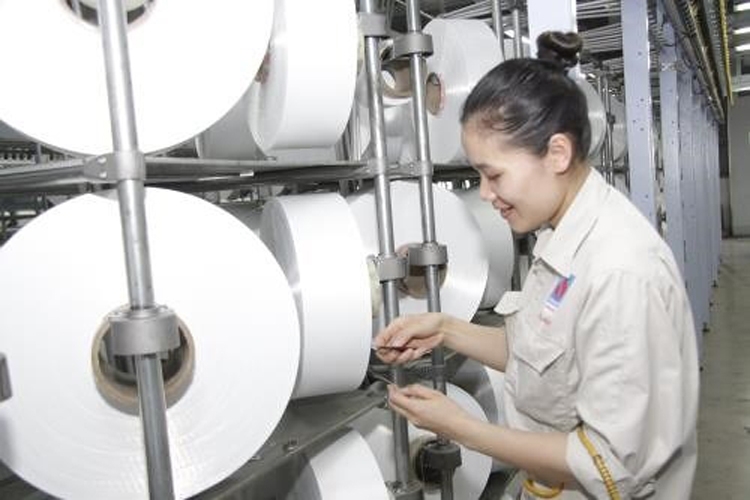 News
News
China is still Vietnam's largest fiber export market . In September, Vietnam exported 77,459 tons of fiber to this market, worth more than 203 million USD. In the first 9 months of 2023, exports to the Chinese market reached 647,862 tons of fiber, earning more than 1.71 billion USD, up 18.1% in volume but down 2.1% in value over the same period last year. 2022. Export price reaches 2,652 USD/ton, down 17.1% over the same period in 2022.
Korea is the second largest export market of Vietnamese fiber. In September 2023, exports of this product to Korea reached 10,898 tons, worth more than 30 million USD, an increase of 0.6% in volume and an increase of 2.8% in value compared to August 2023. In the first 9 months, exports reached 101,880 tons of fiber, earning more than 284 million USD, down 5.78% in volume and 24.2% in value compared to the same period in 2022. The average export price reached 2,788 USD/ton, down 19.65% over the same period in 2022.
 |
| Vietnam earned 3.2 billion USD from exporting which products? |
Ranked 3rd is the US market. In 9 months, Vietnam exported 75,483 tons of fiber to the US, worth more than 108 million USD, down 13.8% in volume and 29.4% in value over the same period. The average export price reached 1,443 USD/ton, down 17.5% over the same period in 2022.
According to Mr. Cao Huu Hieu - General Director of Vietnam Textile and Garment Group , the market trend in the fourth quarter of 2023 has positive changes when the Fed does not raise interest rates in September but postpones it to the end of the year. The US and Chinese markets recovered well, the purchasing management indexes of these two markets were both above 50 points (higher than forecast). Inflation in the EU in September decreased by 4.3% and in September 2023, Vietnam's export turnover of goods increased by 4.6% compared to the same period in 2022. As for the fiber industry, the price of cotton put into production in the third quarter and April 2023 is currently approaching the market price and is at a lower level than the first 6 months of the year, helping the fiber industry to be more effective.
The representative of Vietnam Textile and Garment Group also commented that the overall market in 2024 is more likely to improve demand than in 2023, although the improvement is small (total demand in 2024 is expected to still be 5% lower than 2022). -7%) and the fiber industry may have unexpected developments due to the application of stricter policies. However, the group still proposes a scenario that the fiber industry in 2024 will increase by 10% compared to 2023 due to the increased equipment mobilization rate based on the forecast cotton price of 2.5-2.6 USD/kg.
It is estimated that demand for common textile and garment industry products will increase in the last quarter of the year to serve festivals, so export activities of fiber enterprises are expected to be more vibrant.
Many fiber industry businesses also commented that the level of market improvement is not high. Specifically, according to Mr. Tran Huu Phong - Chairman of the Board of Directors of Vinatex Phu Hung Joint Stock Company (Phu Hung), in the last months of 2023, the fiber industry still does not have many signs of improvement. The Chinese and Korean markets show signs of buying but purchasing power is quite weak. Fiber production costs remain high, electricity increases, interest rates are high, and raw material prices are also high. There are no positive signs in 2024, demand has not yet exceeded supply.
Raw materials account for 60-70% of the cost, this is the decisive factor in the production and business results of the fiber industry. Currently, Phu Hung's cotton inventory price is relatively high due to having to import raw materials at high prices. When the market changed too quickly, orders were closed but customers still canceled, Phu Hung had to reduce prices a lot. Mr. Phong suggested that the Vietnam Textile and Garment Group continue to have timely forecasts for cotton purchasing units more scientifically, to minimize risks.
Ms. Tran Thi Kim Chi - General Director of Phu Bai Fiber Joint Stock Company (Phu Bai) analyzed that yarn production in the coming time must be calculated carefully. Excessive raw material inventory and high prices put a lot of pressure on yarn businesses. Phu Bai is also greatly affected by exchange rates and reduced profits.
Phu Bai recognizes the need to continue to produce high quality yarn, reduce costs, and choose customers. In particular, Phu Bai closely follows the market, realizing that any product in need will increase production and the recycled yarn line is still better than the regular blended yarn line. With such a viewpoint, Phu Bai in 2024 is not too subjective but also not pessimistic in the face of the current unpredictable fluctuations. "We think that the first 6 months of 2024 will still be bad, the last 6 months of 2024 will be better," said Ms. Tran Thi Kim Chi.